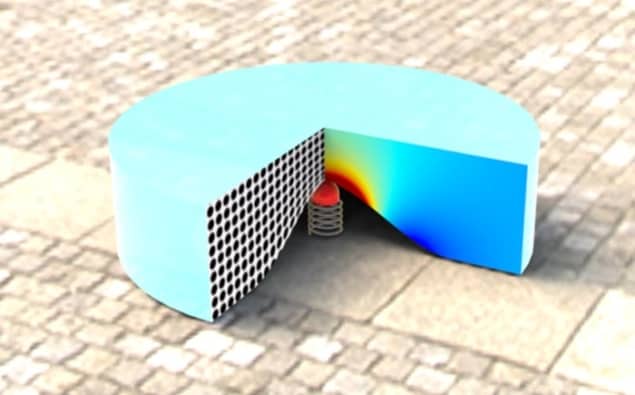
An adaptable “invisibility cloak” that hides objects even as they change shape has been unveiled by researchers in the US and South Korea. The metamaterial-based design works within a range of microwave frequencies and remains insensitive to changes in shape of up to 8 mm. This marks a significant departure from traditional cloaks, which have to be redesigned to compensate for even small changes in the shape of an object. In addition, the new device covers a larger relative range of frequencies than has been achieved with previous cloaks.
Most invisibility cloaks take advantage of the strange properties of metamaterials – collections of structures that are assembled so that they interact with electromagnetic radiation in very specific ways. One useful property of some metamaterials is that they can be used to guide radiation smoothly around an object in much the same way that water flows around a stone in the middle of a river. For a cloak working in the visible portion of the electromagnetic spectrum, our eyes would only detect light that appears to have travelled in a straight line from the space behind the cloaked object, rather than as having travelled around it. Therefore the object would appear invisible.
The practical challenge is designing a cloak with optical properties that change as a function of position so that the device guides a ray of light in precisely the correct way. To do this, physicists have developed a mathematical tool called transformation optics, which “transforms” space in such a way as to make an object disappear in a manner analogous to the coordinate transformations that occur under gravity in general relativity. Using transformation optics and metamaterials, scientists have made real cloaks the work under certain conditions – and mostly in the microwave part of the electromagnetic spectrum.
Shape-shifting design
Existing cloaks are designed to hide an object with a specific shape. If the shape changes, then the coordinate transformation – and therefore the electromagnetic properties – of the cloak must also change. One solution to this problem is to make a “smart” metamaterial that changes its electromagnetic properties in just the right way when its shape changes. That is just what researchers at Yonsei University in Seoul and Duke University in North Carolina have done.
The team’s elastic metamaterial deforms around the object to be cloaked and alters its electromagnetic properties so that even if the object changed shape slightly, it would still remain cloaked. This imposes an extra constraint on the metamaterial – in addition to having the appropriate electromagnetic properties, it must also have favourable mechanical properties.
Computer modelling done by the team revealed that the ideal material would have a negative Poisson’s ratio, which would mean that it gets thicker instead of thinner when stretched. However, “such materials are very rare”, explains team member Kyoungsik Kim. Indeed, the researchers were not able to create the ideal metamaterial with the requisite mechanical and electromagnetic properties.
Elegant compromise
Kim and colleagues did, however, find an elegant compromise. They fabricated a lattice of flexible silicon rubber tubes filled with air. The tubes had outer diameters of 10 mm and walls 1 mm thick, and they were closely packed to form a square-lattice structure. The team found that this metamaterial came very close to having the desired properties and was able to cloak objects from microwaves in the 10–12 GHz frequency range. In addition, such a structure would be cheap to produce on a large scale.
Ortwin Hess at Imperial College London is impressed, commenting that the broadband nature of the cloak alone would be newsworthy. “The fact that one has a broadband cloak is a very remarkable and good demonstration,” he says. “Recently there have been some demonstrations that are more broadband than the initial ones, but here the bandwidth [10–12 GHz] is quite remarkable. The second remarkable element is the fact that the cloaking was achieved while moving the structure.”
Kim’s group is hoping to try to use the innovations to develop a more broadband, flexible cloak for optical frequencies. He says, however, that he is under no illusions that this will be easy.
The research is published in Nature Communications.



